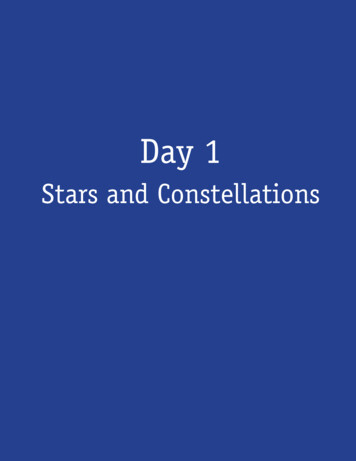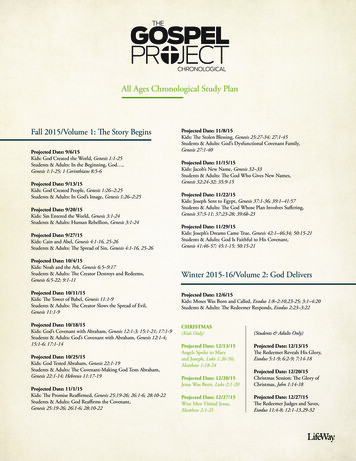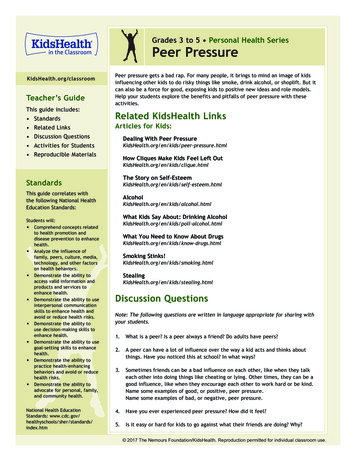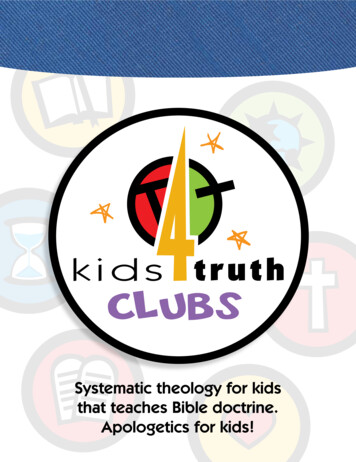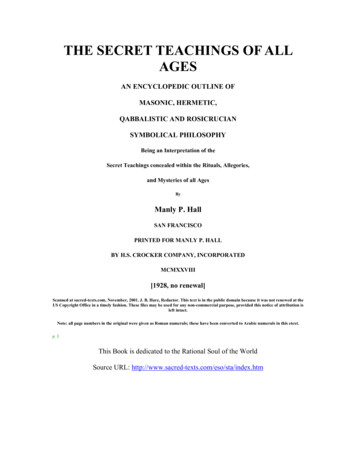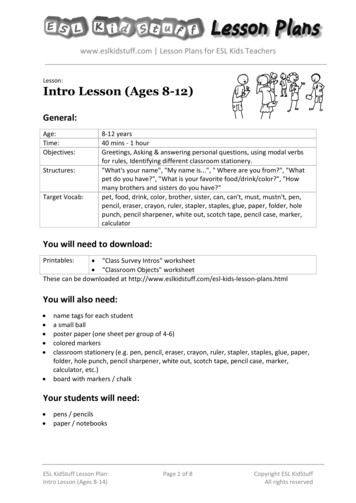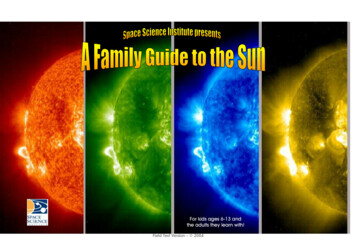
Transcription
For kids ages 6-13 andthe adults they learn with!Field Test Version – 2004
FROM THE DEVELOPMENT TEAMDear Learning Enthusiast,Welcome to the Family Guide to the Sun!The Guide's content develops and re-enforces four overallthemes:We invite you to use the diverse activities and resourceshere to have fun learning about the Sun – the star at thecenter of our Solar System*!····The Guide includes an innovative collection of puzzles,pictures, poetry, and projects, all designed to stimulateenjoyable co-learning experiences between kids aged6-13 and the caring adults in their lives.We encourage you to begin with the Fill-in-the-BlanksGame on p. 16-17 to warm up your minds and hearts tothe Sun and its place in the Universe.Much learning in life takes place in informal environmentsoutside the classroom. We envision this Guide being ofvalue wherever kids and adults find themselves togetherand excited about learning.Before getting started, we strongly urge adults to read the“Tips to Guide Your Child’s Enjoyment of Learning” (p. 4).It is very important to realize that being a good learningcompanion to kids is NOT the same as being the expertwho tells all the answers.Whatever your age or background, we firmly believe thatjust one significant experience of the joy of discoveringsomething for yourself can vastly enhance yourconfidence and interest in learning for the rest of your life.The Guide assumes little or no prior knowledge about theSun or astronomy in general.2The Sun as a starThe Sun's connection to life on EarthThe Sun's “motion” in Earth's skyThe Sun's 11-year cycle of activityBe sure to check out the FAQ at the back of the Guide,which provides general background on the Sun, withquestions posed as kids tend to ask them. We crafted the“Gee Whiz” Facts to elicit the irresistible urge to tellsomeone else about them. Look for terms from theGlossary (on p. 42) throughout the Guide – they aremarked with an asterisk*.We want this Family Guide to be the best it can be. Wesincerely hope you will explore its riches and tell us aboutyour experience.The Development Team- Dr. Cherilynn Morrow (morrow@spacescience.org)- Preston Dyches (dyches@spacescience.org)- Amy Wilkerson (wilkerson@spacescience.org)- Brad McLain (mclain@spacescience.org)Field Test Version – Space Science Institute 2004 Contact: morrow@spacescience.org
TABLE OF CONTENTSTips to Guide your Child's Enjoyment of Learning . 4Discover Why it is Colder in Winter . 26It Moves Because the Sun Shines . 5Observing Where the Sun Sets . 27Names for the Sun Around the World . 6Solar Picnic – What's Different in the Two Drawings? . 28Introducing Solar Maximum and Minimum . 7Sun Story – Shadows and Sun in the City . 30Introduction to the Sun . 8Crossword Puzzle . 32Sun Maze . 10Frequently Asked Questions about the Sun . 34Scale Model of the Sun, Earth and Moon . 12Gee Whiz! Facts about the Sun . 38Color Images:Layers of the Sun . 14Fun Sun Resources:Look at Beautiful Images . 40Sun-Earth Connections . 16Share Fun ActivitiesStorms of the Sun . 17Explore with Background Resources . 41. 40Read a Book about the SunOur Star the Sun Fill-in-the-Blanks Game . 18Get Some Teaching Tools. 42. 43Sunshine for Life – A Poem . 20Glossary of Sun Related Terms . 44A Secret Message about the Sun . 22Acknowledgements . 45Discover Why the Sun Appears to Rise & Set . 24Field Test Version – Space Science Institute 2004 Contact: morrow@spacescience.org3
TIPS TO GUIDE YOUR CHILD’S ENJOYMENT OF LEARNINGBe a guide on the side!This Family Guide is intended to assist you in sharingthe joy of exploration and discovery with the children inyour life. It is a wonderful gift to enjoy our minds at play!6. The Toy Dog Dialogue on the facing page offers oneexample of how a caring adult can lead children todiscover a new and enriching perspective.1. Children are naturally curious and enthusiastic to learnabout the world around them. Listen to their ideas andopinions – they will fascinate you! Encourage yourchild’s inclination to observe, wonder, and investigate.7. Encourage your children to use different dimensions oftheir intelligence to record their impressions andobservations. Telling stories, drawing pictures, creatingpoems or songs, making a photo album or collage,recording a video, and writing in a journal are all waysto remember and share information. Also, watch forStar Challenges throughout the Guide.2. The resources and activities in the Family Guide to theSun can assist you in making enjoyable connectionsbetween the Sun and real places and experiences inyour home, neighborhood, and recreational settings.3. You can be a good teacher, even if learning about theSun is new to you. Good teachers introduce ways tofind the answers, rather than presenting themselves asa source of all information.4. Help your child learn how to ask questions by askingquestions yourself. You are a powerful role model. Evenif you don’t know the answer, you can explore with yourchild to find answers together.5. If you do know the answer, it is often valuable to askleading questions that guide a child to discoversomething new for themselves.4Field Test Version – Space Science Institute 2004 Contact: morrow@spacescience.org
IT MOVES BECAUSE THE SUN SHINESAdapted from physicist Richard Feynman’s 1966 speech to theNational Science Teachers Association, titled “What is Science?”The Toy Dog DialogueChild: Why does the toy dog move?Adult: It moves because the sun is shining.Child: No it doesn't. What does that have to do with theSun shining? The toy dog moves because I wind upthe spring.Adult: Yes, but why are you able to move to wind up thespring?You can use this idea to enjoy connecting sunshine tomany other moving things on Earth.Child: Because I eat.Adult: Okay what do you eat?Child: I eat food.Adult: Where does that food come from?Child: Plants and trees Adult: And how do plants and trees grow?Child: Aha! They grow because the Sun is shining .Adult: Right! So both you and the toy dog move becausethe Sun is shining.For example, cars and trucks move using gasoline, whichcomes from the accumulated energy of the Sun capturedby plants and preserved in the ground as oil.The air moves, making the wind, because the Sun heatssome places on Earth more intensely than others. Watermoves, making streams and waterfalls, because the Sunmelts the snow and ice at higher elevations.STAR CHALLENGELook around you at things thatmove and grow. See how many ofthem you can trace back to beingbecause “the Sun shines”!Field Test Version – Space Science Institute 2004 Contact: morrow@spacescience.org5
NAMES FOR THE SUN IN DIFFERENT LANGUAGES AROUND THE WORLDThe same Sun that travels across your sky each day shines down on people all across theplanet! Here are a few of the names the Sun is known by in other languages ZonMy language is :GüneRMy language is :FrenchSoleilGermanSonneGreekHeliosHawaiianLaMy language is :SunMy language is :ShaMy language is kotaAnpetu wiSwahili**JuaNavajoShaSolTurkishGüneRMy language is :STAR CHALLENGEYou can learn more names for the Sun l* We have chosen to display the flag of Saudi Arabia because of its cultural significance to the Arabic speaking world.** This is the flag of Tanzania, where Swahili is an official language.6Field Test Version – Space Science Institute 2004 Contact: morrow@spacescience.org
INTRODUCING SOLAR MAXIMUM* AND MINIMUM*People all around the world have a name for the Sun.But naming something is not the same as knowing Hi! I'm Max. Some people sayI'm a cool guy with a very“magnetic” personality.Maybe I should have anickname like “Cool Max” or“Magnetic Max”!Max is a wild and rambunctious guy! He is named in honor of solarmaximum – the most active part of the Sun's 11-year sunspot cycle.During solar maximum, the Sun's surface and atmosphere are verymagnetically active. There are many sunspots (see Max's freckles) and ahigher chance of violent solar storms that can enhance auroras, damagesatellites, endanger astronauts and cause power blackouts.The Sun near solar maximum.Hello! My name is Minnie.Most people agree that I'mreally bright, even though I'musually quiet as a mouse.Minnie is a calm and peaceful gal. She is named in honor of solarminimum*, the quiet part of the Sun's 11-year sunspot cycle. During solarminimum, there are fewer solar storms and fewer sunspots (see Minnie'sfair complexion).The Sun near solar minimum.Field Test Version – Space Science Institute 2004 Contact: morrow@spacescience.org7
INTRODUCTION TO THE SUNThe Sun is a seething ball of energy with several distinct layers.1. Core: The core produces colossal amounts of energy,including all of the Sun's light and heat.Here thetemperature and pressure are so great that hydrogenatoms are squeezed together to form helium. This reactionis called nuclear fusion.2. Radiation zone: In the radiative zone, energy fromthe core slowly travels outward. This region is so dense thatthe Sun's energy takes about 150,000 years to work its waythrough.3. Convection zone: In the convection zone, rising andfalling currents carry heat from the radiative zone to thesurface. This nonstop churning is similar to what happenswhen you boil water on a stove.4. Photosphere: The photosphere is what our eyesperceive as the visible surface of the Sun. Here, energyescapes from the interior and streams into the Sun'satmosphere and beyond. The photosphere is home todark sunspots*.7. Flare: Intense explosions on the Sun that spewenormous amounts of energy into space.8. Prominence: Great looping arcs of hot gas that eruptfrom the Sun.9. Corona: The corona is the Sun's extended outeratmosphere. It is the luminous white halo visible in a photoof a total solar eclipse*. Mysteriously, the corona is muchhotter than the surface of the Sun, so hot that it alsoproduces a type of light called X-rays.See REAL images of thelayers of the Sun’satmosphere on p. 14!5. Sunspots: Dark blemishes on the Sun's surface.Sunspots are cooler than the area around them.6. Chromosphere: The chromosphere is a turbulent layerof the Sun's atmosphere just above the photosphere. It ishome to magnificent arcs of gas called prominences*and tremendous explosions of energy called solar flares. Itgives off most of the ultraviolet (UV) light of the Sun.8STAR CHALLENGEDraw your own AMAZING picture of the Sun.It could be displayed online! Visit http://solarcenter.stanford.edu/art.html to find out howto submit your artwork to the Stanford SolarCenter web site!Field Test Version – Space Science Institute 2004 Contact: morrow@spacescience.org
Field Test Version – Space Science Institute 2004 Contact: morrow@spacescience.org9
CAN YOU ESCAPE FROM THE SUN?You are a photon of light Make your way out of the Sun's core* and into space!Pick up letters along the way to spell out a special message about the Sun. (Take a look at Gee Whiz fact #15 on p. 39.)!IGEnergy from the Sun’s core takes 150,000years to reach the photosphere*. So thelight you see today was produced whenhumans were still in the stone age!10Field Test Version – Space Science Institute 2004 Contact: morrow@spacescience.org
CHECK OUT FREQUENTLY ASKED QUESTIONS ABOUT THE SUN!STAR CHALLENGEWant to know the answers to these andmore questions about the Sun? Checkout the FAQ, starting on page 34!Field Test Version – Space Science Institute 2004 Contact: morrow@spacescience.org11
SCALE MODEL OF THE SUN, EARTH AND MOONSunHere are images that show therelative size of Earth comparedto the Sun. Earth is tiny isn't it?This page is too small to showthe proper scale distance fromEarth to the Sun - that part is upto you!First, cut out the images. Thenmeasure about 50 feet (15meters) from the Sun to theEarth. Now you have your ownscale model!MoonEarthIs the Sun nearer or farther awaythan you thought? Remember, eachfoot in your model represents about2 million miles (3.2 million kilometers)in space!12Field Test Version – Space Science Institute 2004 Contact: morrow@spacescience.org
DRAW YOUR OWN PICTURE OF THE SUN!Try to draw: SUNSPOTS PROMINENCE FLARE CORONASee pages 8 and 9 to learn more about these features!Field Test Version – Space Science Institute 2004 Contact: morrow@spacescience.org13
LAYERS OF THE SUNCan you match the labels in the center with the correct pictures?Hint: use the temperatures and the clues from the electromagnetic spectrum on the next page Image #Image #The “surface” of the Sun – the photosphereTEMPº 10,000F, 6000KelvinThe chromosphere – Just above the photosphereTEMPº 7500F, 4000KelvinImage #Image #The upper chromosphereTEMPº 17,500F, 9700Kelvin14The corona – the outermost layerTEMPº1-2 million (F and Kelvin)Field Test Version – Space Science Institute 2004 Contact: morrow@spacescience.org
LAYERS OF THE SUNThere’s more to light than meets the eye! Different kinds of light have different names, different wavelengths, differentfrequencies, and different temperatures. Use this diagram to help you match the pictures and labels of the Sun.Courtesy: NASAANSWERS:X-Ray – 4Ultraviolet – 2Visible Light – 1Field Test Version – Space Science Institute 2004 Contact: morrow@spacescience.orgExtreme Ultraviolet - 315
SUN-EARTH CONNECTIONSWhich of these have you seen with your own eyes?SunsetEarth blocks light from the Sun.Total Solar EclipseMoon blocks light from the Sun.16RainbowSun shines on water droplets in the air.AuroraEerie glow caused by the solar wind.Field Test Version – Space Science Institute 2004 Contact: morrow@spacescience.org
STORMS OF THE SUNTry to match the three basic types of solar storms with how big the Earth would be in each picture.These storms can have significant effects on Earth. (See Gee Whiz fact #6, p. 38)Solar FlareSolar Prominence*– explosions on the surface .Quiet CoronaANSWERS:Solar Flare – 1– plasma archesCoronal Mass Ejection –Solar Prominence – 2Coronal Mass Ejection - 3eruptions from the corona*Field Test Version – Space Science Institute 2004 Contact: morrow@spacescience.org17
OUR STAR THE SUN: FILL-IN-THE-BLANKS GAME – PART 1PART 1: Fill in the blanks with the terms below! Cross out the words as you use them.STARPLANETSEARTHROTATINGFAR AWAYCLOSERRISEWEST100 BILLION93 MILLIONMILLIONWINTERSOLAR ECLIPSESOLAR SYSTEMMILKY WAYCORONAThe Sun is a located at the center of ourNine orbit around the Sun, including the. The Sun is so large that aboutone we live on called . If I amone Earths would fit inside it! The Sunyears old [enter your own age], then I have madeis one of over (100,000,000,000) stars intrips around the Sun during my life [enter yourour galaxy called the .own answer, not provided in list].The Sun is miles from Earth. TheInSun appears to be much brighter than other stars(highest/lowest) in the sky and there arebecause it is much to Earth. Many of the(more/less) daylight hours. In months,stars we see at night are much brighter than our Sun, butthe Sun is lowest in the sky and there are less daylightthese stars are so that we only seehours.summermonths,theSunistwinkling points of light.Each day, the Sun appears to in the eastThe Moon is much smaller than the Sun, but it is also muchandsetinthecloser to Earth so the Moon and Sun appear to be abouttoward the east.the same size in Earth's sky! This makes it possible to see abeautiful total where the Moon blocksthe inner light from the Sun, revealing the luminous, whitehalo of the Sun's .18Field Test Version – Space Science Institute 2004 Contact: morrow@spacescience.orgbecauseEarthis
OUR STAR THE SUN: FILL-IN-THE-BLANKS GAME – PART 2PART 2: Fill in the blanks with the terms below! Cross out the words as you use them.1 LOWINGSOLAR MAXIMUM*ASTRONAUTSAURORASPLANTSBLOWINGSOLAR WIND*The Sun puts out huge amounts of energy, but EarthThese particles interact with Earth's magnetic field andintercepts onlyupper atmosphere, causing the (Northernof this energy.TheSun's light keeps the and trees growing.and Southern Lights).The Sun's heat melts the ice and snow and keeps thewaters . The Sun warms the surface ofDisturbances in the solar wind* caused by storms from theEarthSun can enhance the auroras, damage satellites, andunevenlyandkeepsthewinds.endanger in space. In 1989, millions ofpeople in the Canadian province of Quebec lostPlants and trees get their life energy directly from the Sunelectricity due to the effects of a violent solar storm (athrough a process calledsolar flare).Pigs, cows, chickens, and other gettheir energy from the Sun indirectly by eating things thatThe 11-year solar cycle* alternates between times of lowcome from plants and trees (like seeds, nuts, grains, fruitsand high solar activity.and ).less active, with very few magnetic dark patches calledNear solar minimum*, the Sun isand fewer solar storms. Five to sixThe Sun gives off more than the light and heat needed foryears later, near , the Sun is verylife. The is a million mile-per-hourmagnetically active with lots more sunspots and solarflow of charged particles that continuously streams fromstorms.the Sun.Field Test Version – Space Science Institute 2004 Contact: morrow@spacescience.org19
SUNSHINE FOR LIFEby Cheri Morrow*Our Sun is a cool star that lights up our daysAnd shines ever brightly with life-giving rays.The Sun seems so low on those short winter days –Our natural cycles – the air, water, leaves –They say from the Sun, we are tilted away!Are run by the sunlight our planet .The air is much colder – it might even snow!If so we'd be lucky, and sledding we'll .As Earth orbits* 'round to its summertime place,So long is the daytime! So high the Sun's face!The Spring lures the flowers with life-giving Sun,Enjoying a picnic, we might have a hunchAnd more daylight hours means more time for !That sunshine helped fashion the foods in our !We watch for the sunrise at this time of year,And try to predict where the Sun will appear.The Autumn brings changes – now day equals night –It's time now to pick what the Sun has made ripe!We also love sunsets and skies red and pink.The apples and pumpkins we'll make into piesWith Earth turning eastward, the Sun seems to !Have soaked up some sunlight that beamed from ourAnd when colors fade, so we see all the stars,!We hope we might find one as awesome as ours.*Poem 2003 Cheri Morrow. Used with permission.skiessink20fungolunchreceivesSTAR CHALLENGEWrite your own poem or song aboutthe Sun or draw a picture about howthe Sun supports life on Earth.Field Test Version – Space Science Institute 2004 Contact: morrow@spacescience.org
COLOR US!Field Test Version – Space Science Institute 2004 Contact: morrow@spacescience.org21
A SECRET MESSAGE ABOUT THE SUN!Use the key on the next page to fill in the blanks beneath each picture.THE SUN'S KEEPS THE AND GROWING.THE SUN'S HEAT THE AND TO KEEP THE FLOWING.THE SUN WARMS THE SURFACE OF UNEVENLY, AND THIS KEEPS THE BLOWING.THE SUN’S ACTIVITY KEEPS THE AURORAS .22Field Test Version – Space Science Institute 2004 Contact: morrow@spacescience.org
USE THIS KEY TO DECODE THE SECRET MESSAGEEARTHGLOWINGICELIGHTMELTS PLANTS SNOW TREES WATERS WINDS Field Test Version – Space Science Institute 2004 Contact: morrow@spacescience.org23
DISCOVER WHY THE SUN APPEARS TO RISE & SETAdapted from Kinesthetic Astronomy: The Sky Time Lesson by Morrow and Zawaski[This activity can be done alone or in a larger grouparranged around the balloon.]The Sun only appears to rise in the east in the morning,travel across the sky, and set in the west in the evening.Follow these simple steps to learn what’s REALLY happening.1. Find a helium balloon -- a yellow one is bestbecause you will use it to represent the Sun.2. Tie the balloon to something so that it floats about3 feet (I meter) off the floor or ground.3. Write “E” for east on a small slip of paper and “W”for west on another slip of paper and keep themhandy.4. Stand about 8-10 feet (3 meters) away from theballoon with the front of your body facing directlytoward it.9. So as you face the “Sun” with North America on yourchest. What time of day would it be along a linedown the middle of the front of you?10. Now turn around with your back to the “Sun”. Whattime of day would it be now? What would you seein the sky at this time of day?5. Pretend that your upper body represents the wholeplanet Earth.6. Put a hand on your “North Pole”. Where is it? Wherewould your Equator be?7. Say that North America is out on the front of yourchest. Which of your hands is toward the east andwhich is toward the west?8. Where would South America be? What countrieswould be on your back? Where would Australia be?24Field Test Version – Space Science Institute 2004 Contact: morrow@spacescience.org
11. So while you are seeing stars at midnight in NorthAmerica, people on the other side of planet Earth inChina and Asia are seeing the Sun at noon.12. Now turn back around to face directly toward theSun. This is your noon position.13. Hold your arms outstretched and make a 90-degreeturn toward your left (toward the east).14. Look down your right arm to see the Sun alongsidethe “W” in your right hand. What time of day wouldthis be when the Sun is about to disappear in thewest?15. Keep turning to the left until you are again atmidnight position. From midnight position makeanother90-degree turn to your left (toward theeast).16. Look down your left arm as the Sun re-appears infront of the “E” in your left hand. What time of daywould this be? [midway between midnight & noon]17. Does it make sense to you that the Sun could riseand set because of Earth’s rotation?18. How long does it take for Earth to make onecomplete rotation?Write the correct times of day for the boy rotating below(Choose from Sunrise, Sunset, Noon or Midnight)1.2.3.4.Field Test Version – Space Science Institute 2004 Contact: morrow@spacescience.org25
WHY IS IT COLDER IN WINTER?Adapted from Kinesthetic Astronomy: The Sky Time Lesson by Morrow and ZawaskiEarth takes one year to orbit the Sun.Earth’s orbit is nearly circular1. Pretend you body is Earth in orbit around the Sun. Let a heliumballoon be the Sun.So, Earth is about the same distance from theSun no matter the season (summer, fall,winter, spring)2. The top of your head is Earth’s north pole. Pick a point on the ceilingto be the North Star (Polaris). Tilt your head toward Polaris, like the kidsin the drawing below.SO WHY IS IT COLDER IN WINTER?3. Try to “orbit” the Sun while keeping your head tilted toward Polaris.SpringSummerWinterFallWhen your northern hemisphere is tilted away from theSun, will the Sun appear higher or lower in the sky?The hemisphere which is tilted away from the Sun is inwinter. The Sun appears lower in the sky, giving fewerdaylight hours, less time to heat the planet’s surface –thus making colder temperatures.26What season is the girl’sNorthern Hemisphere in?What season is the boy’sNorthern Hemisphere in?ANSWERS: For their Northern Hemispheres, the girl is in summer; the boy iswinter. What about their Southern Hemispheres?Field Test Version – Space Science Institute 2004 Contact: morrow@spacescience.org
OBSERVING WHERE THE SUN SETSAdapted by permission from PASS (Planetarium Activities for Student Success), Vol. 11 Astronomy of the Americas.This activity can be done from a place in yourneighborhood. When you complete it, you will havecreated a horizon Sun calendar much like ones that havebeen used in many Native American tribes.Materials: Pencil and PaperMagnetic CompassOptional: CameraWhat to Do:1. Select a position where you can observe the setting Sun.Note where on the horizon the Sun sets on a given night.Make a drawing or take a picture of the horizon in thatgeneral area.2. Using a magnetic compass, mark the compassdirections northwest, west, and southwest on yourpicture or drawing.3. Once or twice a week for the next month, mark thelocation where the Sun sets for each clear day, andrecord the date and time of the sunset. Be sure toalways make your observations from the same spot.4. Discuss results with friends or family members. Does theSun set farther to the south, farther to the north, or in thesame place on later days as compared with the firstday?During summer months theSun is highest in the skyand sets north of west.During winter months theSun is lowest in the sky andsets south of west.Field Test Version – Space Science Institute 2004 Contact: morrow@spacescience.org27
SOLAR PICNIC – WHAT ARE THE SEASONS IN THE TWO DRAWINGS?This family is enjoying a picnic at the same time in the afternoon, but on two different days of the year.Can you find 10 things that are different between the two images? Can you guess the seasons?Be sure to note what’sdifferent about the Sun!A.28Season:Field Test Version – Space Science Institute 2004 Contact: morrow@spacescience.org
SOLAR PICNIC – WHAT ARE THE SEASONS IN THE TWO DRAWINGS?STAR CHALLENGEMake a list of things that aredifferent in the two drawings, thenmake a list of what’s different in yourneighborhood at different times ofyear.Season:B.Field Test Version – Space Science Institute 2004 Contact: morrow@spacescience.org29
SHADOWS AND SUN IN THE CITYby Preston DychesIn the city we have a lot of TALL buildings. We have carsand streetlights and statues. We also have shadows.(my Dad told me that). I looked down at the street below,and saw a bus stopping in the shadow of my building.One sunny morning on my way to school, I passed thisstatue in the park near my house. I looked down at theshadow cast by the statue and saw that it was long andpointing west. Later in the day when I went home, theshadow was pointing the other way, to the east. “How didthis happen?” I wondered.Suddenly I understood! The Sun is in a different place inthe sky at different times of day. The Sun was behind mybuilding at sunset and the building cast a shadow on thestreet below. The shadow pointed to the east, away fromthe Sun. I raced downstairs and over to the park toconfirm what I had guessed.The next day, I asked my teacher, Mr. Ryan, about theweird behavior of the statue's shadow. His face brightenedand he seemed really glad that I had asked. But then hedid something weird. He refused to answer my question!He told me to look at other shadows on the way homeincluding my own, and see if I noticed anything thathelped me figure this out for myself. Great. Big help hewas.There, I found the statue's shadow, and my own, andeverything else's were pointing to the east, just like the bigshadow cast by my apartment building. It all depends onwhere the Sun is in the sky!So I walked home, looking at lots of shadows. I looked atthe lamppost's shadow outside the school building.I observed at the shadow of a parked car on the street.I looked at my shadow. When I got to the park near mybuilding, I saw the statue's shadow again, pretty much thesame as it had been the day before. I didn't get it. Theanswer to my question just wasn't coming to me. “Mr. Ryangave me too much credit for being smart,” I thought.When I got home, I went into my room and tossed mybooks on the bed. I went over to the window and lookedoutside. I thought of how pretty the sky looked at that timeof day, just before sunset. I couldn't see the Sun from mywindow, because it faces east and the Sun sets in the west30The next day I told Mr. Ryan what I had discovered aboutshadows and the Sun. He said he was impressed, but thenhe asked me if I noticed shadows changing in lengthduring the day. I said, “I guess,” but he wouldn't acceptthat. He told me to take another look and give him myanswer the next day.Well, I finally figured it out, but it took a little help from myteacher. I’d tell you the answer, but it might be more fun ifyou see for yourself. Try it!After you read this story,check out your ownshadow at different timesof day. Does it point indifferent directions?Field Test Version – Space Science Institute 2004 Contact: morrow@spacescience.org
Field Test Version – Space Science Institute 2004 Contact: morrow@spacescience.org31
CROSSWORD PUZZLE ABOUT THE SUN AND SUN-EARTH 64029303331343835363941Cherilynn UMNWINTERSUMMERSSPR
Minnie is a calm and peaceful gal. She is named in honor of solar minimum*, the quiet part of the Sun's 11-year sunspot cycle. During solar minimum, there are fewer solar storms and fewer sunspots (see Minnie's fair complexion). The Sun near solar maximum. The Sun near solar mini
